Six North Faces of the Alps: Aiguille du Dru
The second in the North Faces of the Alps series from Glenmore Lodge Instructor and IFMGA Mountain Guide Stuart McAleese takes us to the Chamonix valley and the Aiguille du Dru. Les Drus, which stands proud high above the village of Les Praz.
.
The Route
Pierre Allain route
Time taken: 17hrs
Climbing partner: Will Harris (total hero, Alpine mountaineer and climber, Aspirant IFMGA Mountain Guide)
.
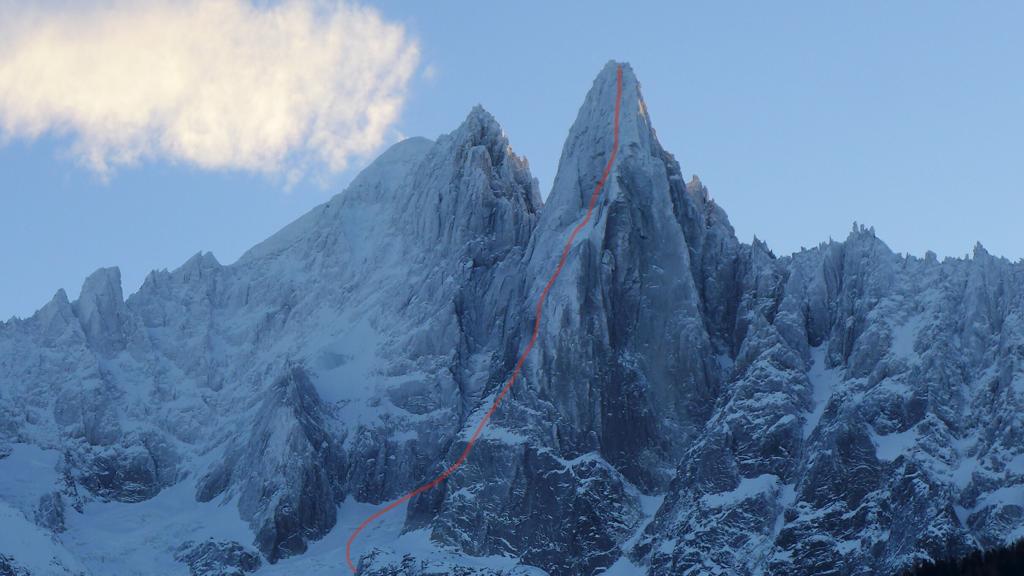
The route up the North Face. Photo credit IFMGA Mountain Guide Tim Neill
Trip Report
A last-minute change of plans and I had 2 weeks of free time. Initially I was happy for a rest but then my thoughts quickly turned to the mountains and was looking for a big adventure and challenge.
I was in Switzerland based in a small Alpine village called Leysin, high in the mountains with superb views of Lake Geneva and across to the big alpine mountains of Chamonix, the Valais and the Bernese Oberland. I was in a small local café and it was raining outside. Drinking coffee in the rain and looking at the weather forecast I could see the weather was due to improve and set in for a few days. I messaged a friend, Will, who lives in Chamonix. He was free for the week and keen for a big adventure. I mentioned the Dru and he was thinking the same too.
It was on…over the next 24 hrs we chatted about plans and logistics and I got more excited about the adventure. An early start from Leysin the next day and all bags semi packed for the adventure, I was on my way over to Chamonix.
On arriving the weather was good and whilst Will was working, I made plans to climb in the valley with friends. This was nice, sport climbing and a chance to relax. Looking up at the Dru, the climbing felt like a good warm up and a way to contemplate plans and prepare.
After some final food shops and kit checks the next day, bags were packed and we met up early in Chamonix. We cross checked everything and our last challenge was getting to the Dru that afternoon.
There was a new access track to the mountain, with the old ladder access route to the Dru / Charpoua hut now removed. Our immediate thoughts were on locating this new access route off.
.
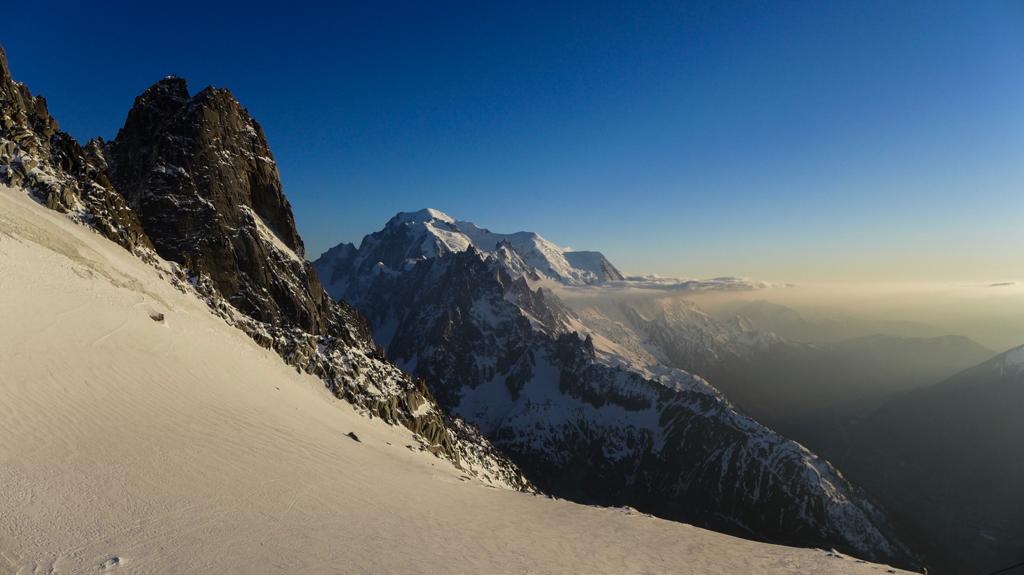
The Dru, with Mont Blanc in the distance. Photo IFMGA Mountain Guide Tim Neill
.
Will and I had done the walk to the base of the Dru before. We both knew it was a hard steep walk and we expected it to take around 4 to 5 hours. We really wanted to get there in time to find a comfortable bivouac and rest before the early start, but as with all these good adventures things sometimes don’t go to plan…. Thankfully, pushing on and good time keeping ensured we got to the base of the Dru in time to look for a bivouac site for the night.
We were amongst big boulders at a safe distance under the Dru on the edge of the glacier, this was our bivouac site and we now had to look for a sheltered cave ideally. Around 10 years ago I slept in a small cave here with my friend Nick Bullock, prior to our 2-day ascent of the American Direct. I remember it had it’s own resident mouse that woke me for a staring competition at 1am. The mouse won by the way.
Unlikely to find the same cave bivouac however, we were looking for something similar, as it was due to rain that evening.
Small cairns appeared as we walked through the boulder field and we could see one built unusually close to a boulder, with a closer look we found it marked a good-sized cave prepared, cleaned out and levelled inside by other climbers. Relieved to have found something comfortable we relaxed and got our sleeping bags out and got organised for the evening. The shelter was level inside, and you could lay out properly, but it was only tall enough to crawl in and out.
.
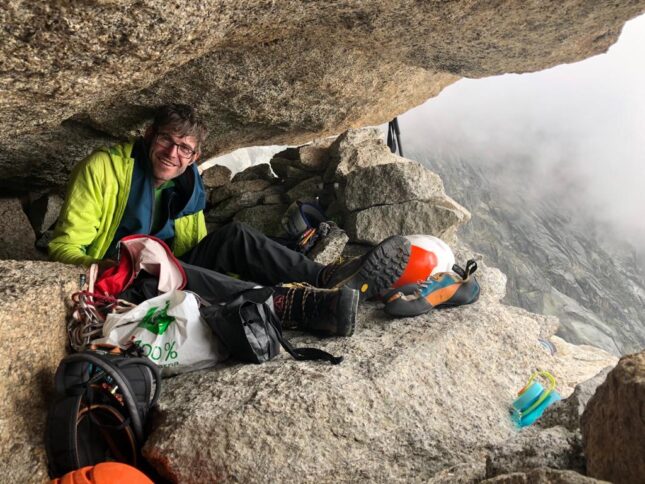
Will in cave getting ready for an early start
Once our kit was in and we were settled, it was nice to relax and reflect on the day looking down to Chamonix. Looking up at the Dru immediately above us we talked over plans for tomorrow and had a look over the topo and route descriptions. It was going to be dark soon, and we were both keen to try and recover as much as possible before our 03:00 alarm. Our plan was to make it to the summit and carry on down to the Charpoua hut in one go, in a day and without a bivouac on the route.
The climbing logistics were to lead climb long sections at a time and then swap over, otherwise known as block leading. This saves time on swapping gear over at every belay and often the lead climber can develop a focus and pace/momentum. This can be very efficient on average terrain where there aren’t any obvious changes or difficulties.
.
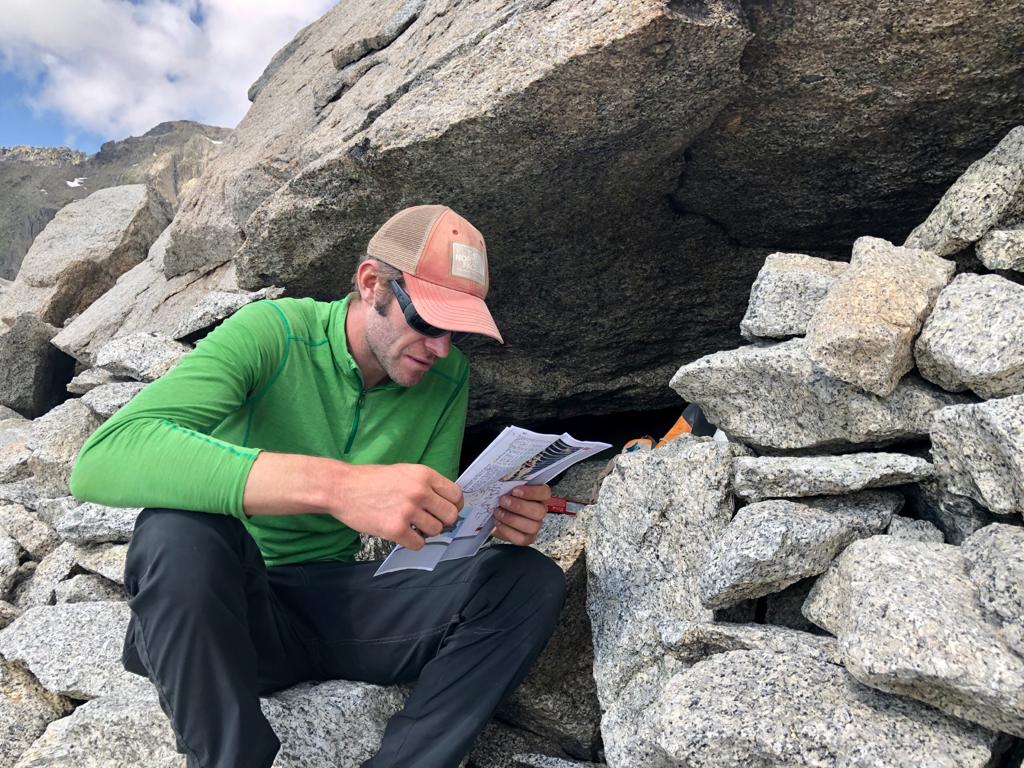
.
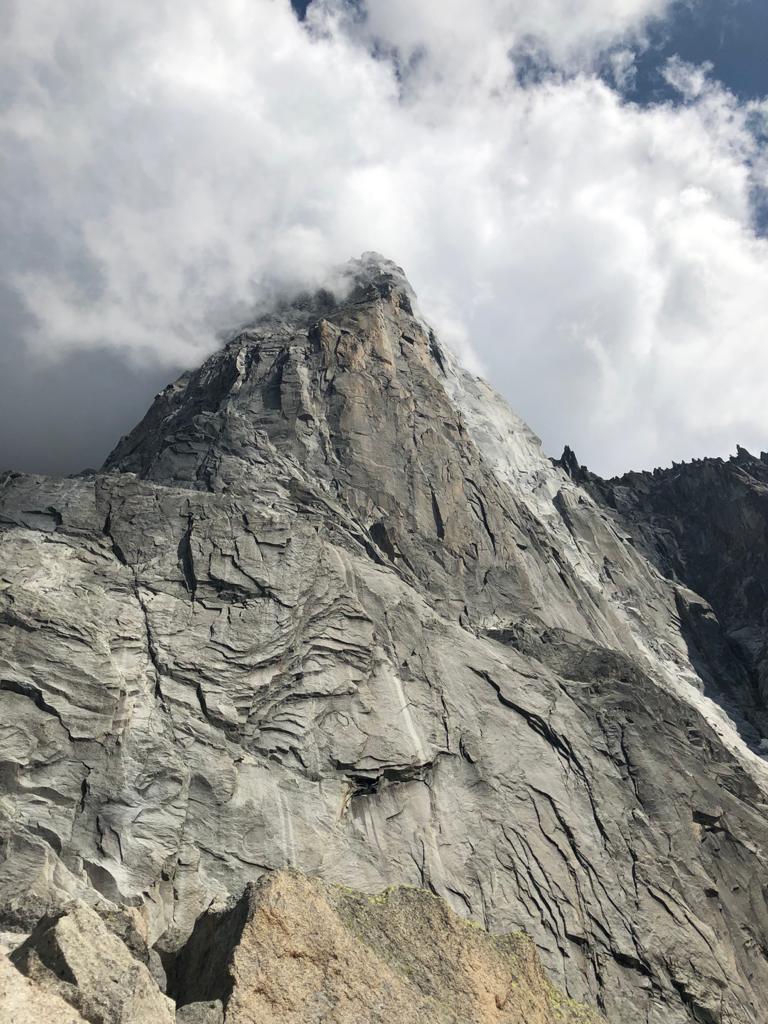
View from the bivi, the west face of the Dru
.
Without a stove I stuffed some snow into my half full water bottle and laid it out in the evening sun, hoping it would melt and top up my water for the following day. We crawled into our cave and tried to sleep, tired from the hard work and walk here, but it was hard not to feel some anticipation for the morning and the big climb that lay ahead.
03:00 and it was dark and cold, Will checked the weather and said it was thick cloud and wet outside. Not wanting to get wet on the approach we decided to give it 40 minutes more and stay in our sleeping bags, delaying the inevitable but at the same time appreciating a little more rest. The 40 minutes passed quickly, time was up, and it was now or never.
Leaving the bivouac, we arrived at the Glacier and put our crampons and started the steep walk to the base of the huge North Face. Crevasses started to appear out of the dark, so these needed to be negotiated carefully. Like being in a maze sometimes, this is guess work and in the dark it is even harder to see the way clearly. Some of the crevasses we had to walk and climb around were big and seemed bottomless in the dark. Soon we could see the North Face and what we thought to be the base of the route. The next problem was getting off the Glacier and on to the rock and into climbing mode.
There was a big bergschrund/crevasse at the base of the route which looked like a safe and flat place to gear up, so we climbed down a few meters into the crevasse.
Right against the rock now we could belay and start rock climbing from here, so we slowly got the ropes out and swapped crampons and big boots for chalk bag and rock shoes. Trying to be efficient as possible in an uncomfortable and cramped space in the middle of the night, we chatted about who was going to lead first and prepared for the climbing to start.
Just at that moment a sofa sized block of snow we had been standing on / near to, gave way and Will disappeared into the crevasse. Surprised as we had judged the snow stable and the position to unfortunately be the best place for us to gear up. I saw his head torch disappear and immediately shouted ‘Will?! Are you ok?’ Luckily the crevasse was not very deep and had only slipped with the block a little way, but still this was the last thing we needed.
Relieved we were ok and uninjured, we quickly looked around at our gear hoping we had not lost any equipment. I climbed down into the crevasse to retrieve some of the gear that had fallen and had to use my ice axe to dig out one of our ropes that the block of snow had fallen on to. All sorted and ready to climb we looked at each other and hoped that this was to be the first and last drama of the day to deal with. Quickly putting that behind us Will chose to lead first and with headtorches on he set off. We were now in climb mode.
Long pitches and glimmers of each other’s headtorches far away, I started climbing and tried to ignore how heavy the bag was and instead focus on the climbing. Will made good progress climbing the initial gully, which was loose in places and required lots of caution. It was getting light as we arrived on a shoulder approx. 200m up the start of the route.
As the plan was to block lead and Will had just climbed for around 2 hrs, it was time to swap over and it was now my turn to lead climb.
We swapped over the gear and checked on progress, pleased we were going well, and the weather was clear, we were happy and feeling good.
With the bag still feeling heavy the route and line to follow was obvious at this stage, linking cracks and ramps up and rightwards. Pitch after pitch this kept on going, the climbing never desperate but just lots of it.
It was all quite manageable even with a heavy rucksack on too. We were leading long pitches and even moving together at times if the climbing was easy enough. At belays we would swap the rack, sort the ropes and if there was time a quick glug of some power gel, then off climbing again. A good belay was one where you were able to take your bag off for a moment. We were working hard and making good progress, as every minute counted, we were against the clock. Time wise, at the very least we had to be above the niche before the daytime temperature rose around midday. However our plans were to summit and descend the other side of the mountain that same day.
.
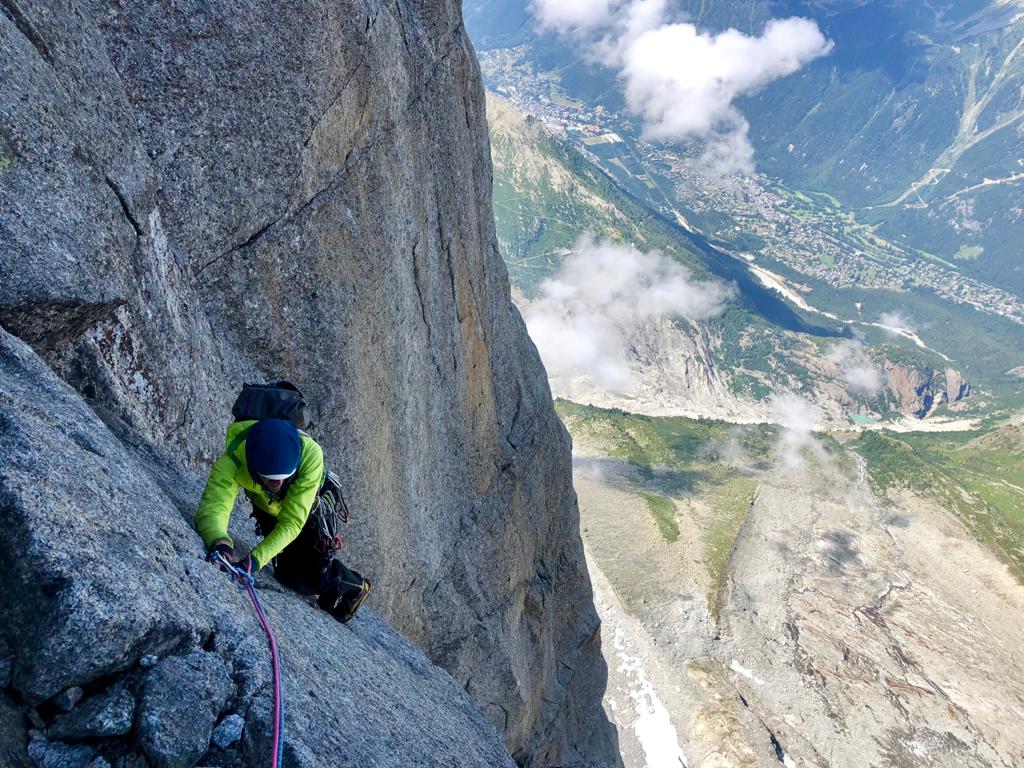
.
Getting towards the end of my lead stint there was a few important sections to pass, a couple of chimneys and the fissure Lambert.
I carried on climbing up and rightwards and out of sight of Will at the belay. Around the corner I was faced with a big chimney that had to be climbed, it was filled with snow and ice for the first third and just arm span wide, totally featureless without hand holds and foot ledges. It looked terrifying, desperate and I hate chimney climbing as they are nearly always semi-horrific and involve a bit of a fight. Trying not to think about it too much, I paused and looked for how I could climb this. There were no foot holds so it was going to involve whole body climbing, back and foot technique if I was lucky.
At first I couldn’t even get in the chimney, so had to hang my bag off some gear at the base of the chimney, I explained all this to Will way below and also expressed my doubts, Will was amazing and replied with patience, support and encouragement. With no time to waste I got stuck in and tried to climb the snow and ice in the back of the chimney, but my rock shoes were slipping on the ice. I had no choice but to commit to the chimney and continue to wedge my back, shoulders, elbows and feet against the walls.
With no cracks for gear, I was aiming for a peg I could see near the top of the chimney, I kept fighting my way up always looking for a hand hold or foot hold but nothing. My whole body wedged high in the chimney now and I could see a tiny edge for my right foot, I quickly assessed that if I gained this and my foot held, I would be able to reach the peg for safety. The consequences of a fall from here were not good but I had little choice and trusted the tiny edge for my right foot, braced my left shoulder against the wall and dug deep. I clipped the peg, carried on up to the belay. Not my favourite style of climbing because chimneys can often feel insecure and strenuous, so I felt relieved for getting on with it and in good time too.
The ‘fissure Lambert’ was next, a long-exposed traverse into a steep wall. Here you could look down the Dru and could see Chamonix. You start to feel high above the valley; it’s a great climbing atmosphere. This was easier than we expected and it was nice to be able to monitor our progress on the topo. We could see we still had far to go but we were both feeling good.
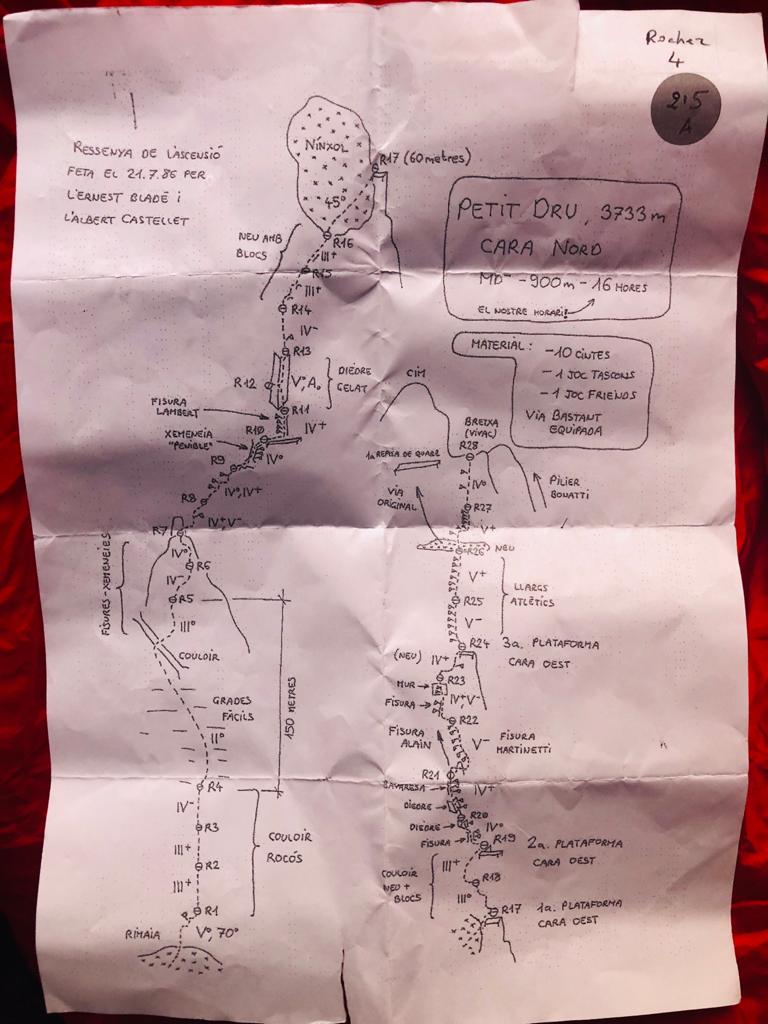
.
Will took over from now, and had a tough wall and groove covered in verglas. It was desperate and took a while for Will to safely climb as everything was covered in ice. Once past this section we knew we were close to the Niche; around us on the rock walls were recent rock scars, evidence of falling rocks from the Niche above. This reminded us to keep moving as we did not want the risk of rockfall, which was possible with a daytime rise in temperature. For now it was still cold and well before midday and we had heard no falling rocks so far.
The rock climbing was easier now and we could feel we were close to the Niche, but Will’s feet were cold having been in rock boots, so he changed into his mountaineering boots to continue. We needed it to be cold as this mountain has gained a reputation over recent hot summers for rockfall, especially out of the hanging icefield in the middle of the face called the ‘Niche’.
Long pitches and at times moving together, we arrived at the Niche. This is normally a big snow ice field where climbers normally change to boots and crampons, but for us it was a wasteland of grey hard ice with very little loose rock around, and in parts clean rock where the ice had disappeared to leave it bare. We continued climbing 60m apart, traversing under the icefield carefully, more like serious exposed scrambling than climbing. As we were moving together on the traverse, I was constantly on the look out for rock runners to make us safe. Once past the Niche we could breathe a little knowing we were above the main rockfall risk, so I looked for a ledge and belay where we could regroup and have some food.
Above us the climbing was steeper and we had a couple of options, both looked similar and each had evidence where climbers had been before. Fixed rope, pegs, scratches from crampons and general wear and tear for traffic were the clues we were looking for to help keep us on route. This becomes a little more automatic over time and with experience, but still sometimes you can get it wrong and follow a false trail. Forced to decide between two possible crack lines I chose the right hand of the two. Good climbing and solid rock took me to a dead end in space! I pulled up to look down the West Face and into an abyss of rock, all of it blank and unclimbable. Not surprisingly there was an abseil point here, so I proceeded to do what lots of folk had done before, abseil back down and take the left-hand option. It is frustrating to have wasted some time and energy, but reassurance and understanding from Will below helped keep things cool.
More steep climbing pitch and we were back on route, checking the topo and making sense of the rock features, spying belays and signs of other ascents in the past.
We were now high on the face, climbing in cracks, grooves and chimneys on our way to the summit of the Petit Dru.
.
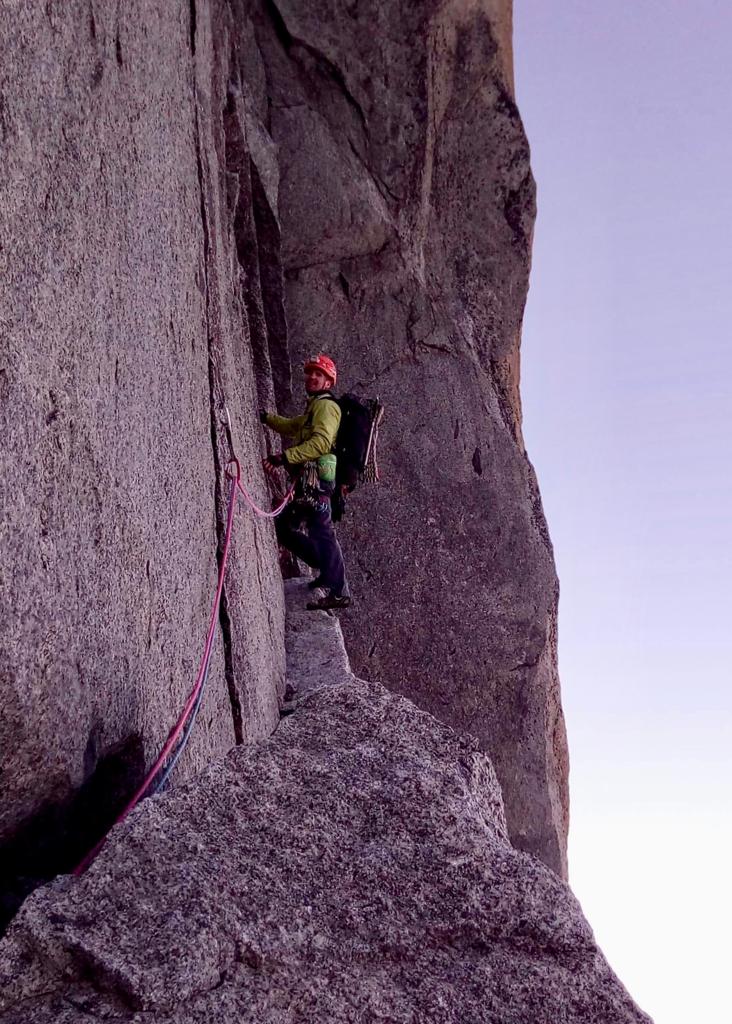
.Photo credit Will Harris, IFMGA Aspirant
Photo credit: Will Harris IFMGA Aspirant Mountain Guide
.
A few change overs and taking turns to block lead climb, long pitches, some steep climbing and massive chimneys took us to signs of the Petit Dru summit area.
We paused for a moment just under the summit of the Petit Dru for a break, some food and water. We were making good time, but both fully aware of fatigue levels we kept checking on each other and pushed on.
On route we climbed through a small hole in the cliff to appear on the south side of the mountain, immediately we could feel the warmth of the sun and both needed to take a layer off and pop on our sunglasses.
Part of our plan was to climb to the higher summit of the Grand Dru, which was an hour of climbing away from the Petit Dru. This was due to the availability of a safer abseil descent down the south face of the Grand Dru. In order to do so we had to traverse the Petit Dru summit via a huge complex traverse, then climb up the other side to the Grand Dru.
Climbing now in the full heat really affected fatigue levels and I started to feel tired, the bag still felt heavy and some steep climbing pitches became harder. At the same time the route also became less obvious.
Analysing all our topo information and guidebooks to ensure we were on the right track, it was fair to say we had got a little lost and it was just best to work together and keep climbing up.
Combined with fatigue and route finding issues, some Alpine stress was kicking in. Will was strong but I remember feeling pretty wiped out, climbing up a few dead ends, the climbing taking longer and feeling harder, we were slowing down and it felt like we would never get there.
.
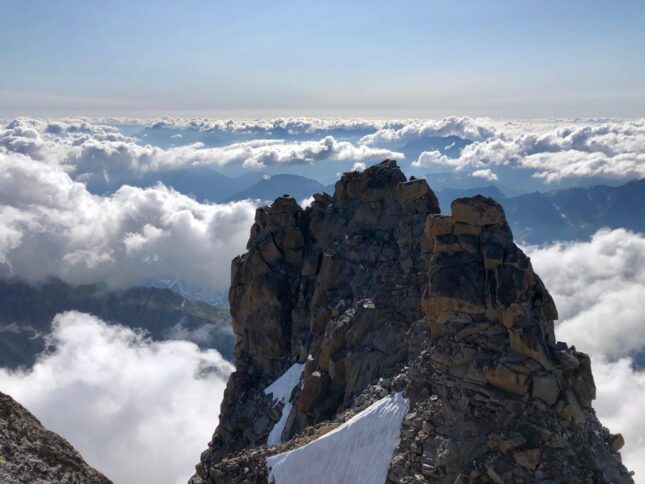
Looking across to the Petit Dru from the final pitches of the Grand Dru
We arrived on the summit area of the Petit Dru later than we had hoped, feeling that the traverse had taken longer than expected. Now we had to traverse to the Grand Dru, still with some steep pitches of climbing to get to its summit.
With no water left and with food at a bare minimum we kept going and arrived at the final few steep sections of climbing to the Grand Dru summit. Will forced on, leading the last few hard pitches, some of which were exposed and technical, which at the time of day felt tough. Will did an amazing job and we smiled seeing the summit of the Grand Dru.
We walked a short distance over boulders to the summit block, sat down had what little bits of food that were left and rested for a moment. A little tired and both happy to be on the summit, pleased with our efforts. We chatted, reflecting on the climb and its challenges. We had been on the go climbing for approx. 14hrs and our thoughts quickly turned to what now?
It was late in the day approx. 18:00 and sunset was around 21:30, leaving approx. 4hrs of daylight.
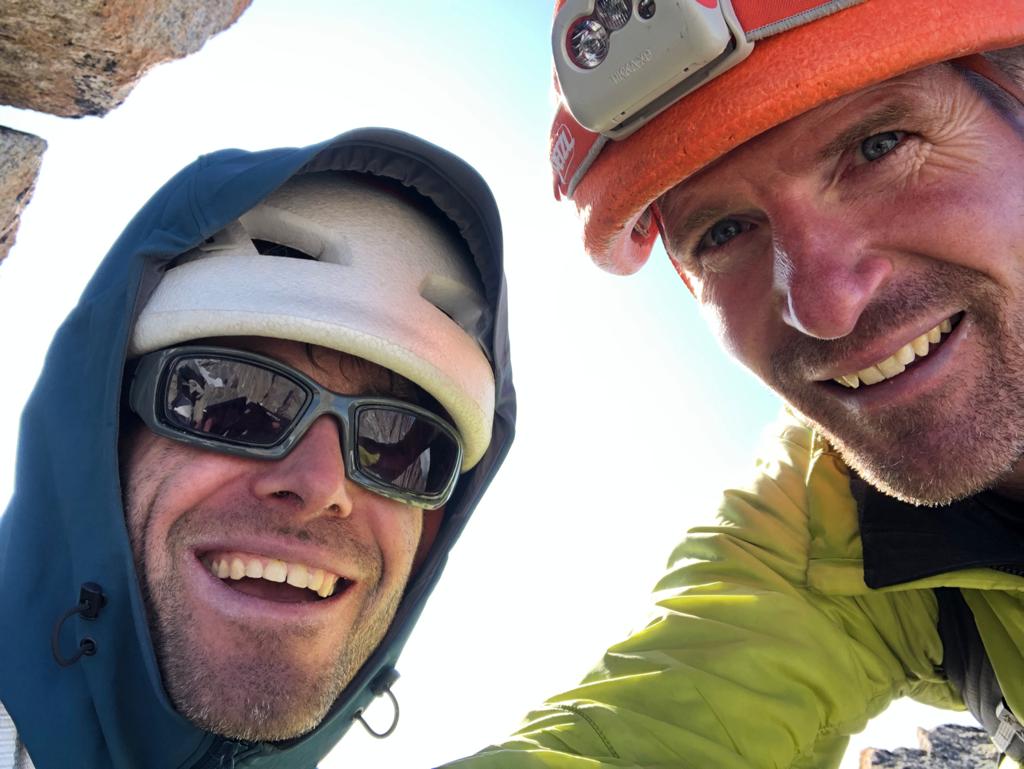
Summit Selfie!
We now had two options. No 1, Bivouac on the summit, rest and do the descent in the morning with plenty of time and daylight, or 2, do the descent now and get to the Charpoua hut late that evening.
.
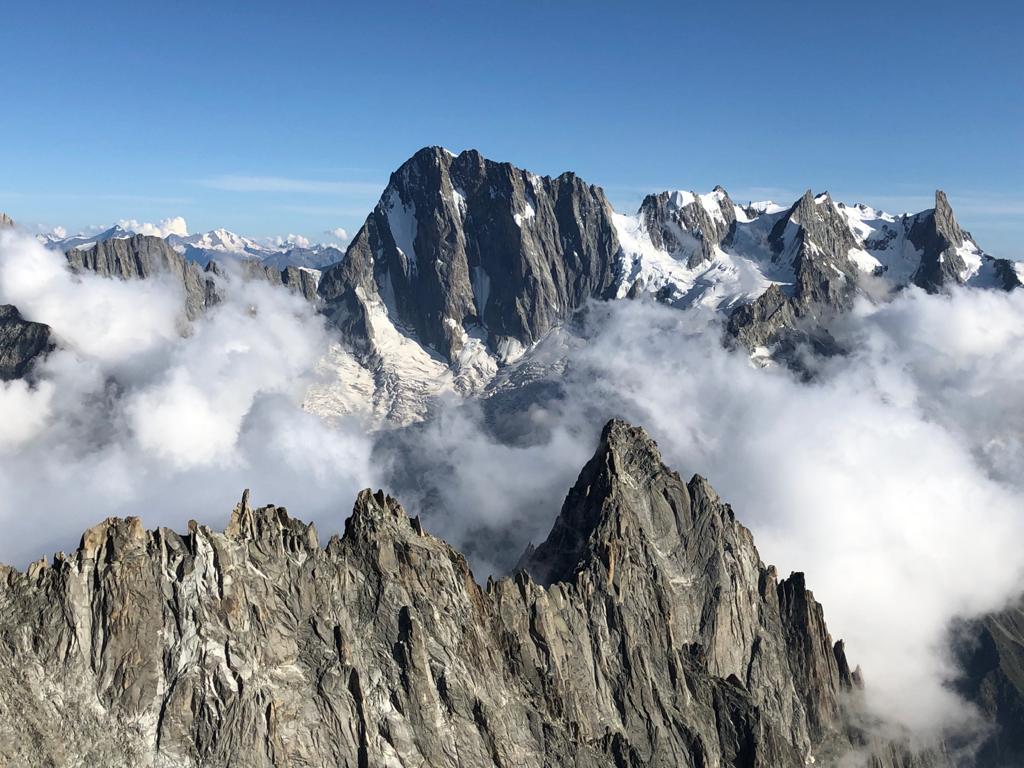
View across to the Grand Jorasses and the Moine
.
We chatted this over and both were possible, however we had no water left so we felt it better to continue, rather than the alternative of a long bivouac on the summit, to only get further dehydrated in time.
All we knew about the descent was that it was a regular abseil descent for this route and we had a detailed topo/description from a guidebook. We had a short ridge from the summit to descend and slowly try and locate the first abseil point, this took some time and we also wanted to be sure.
.
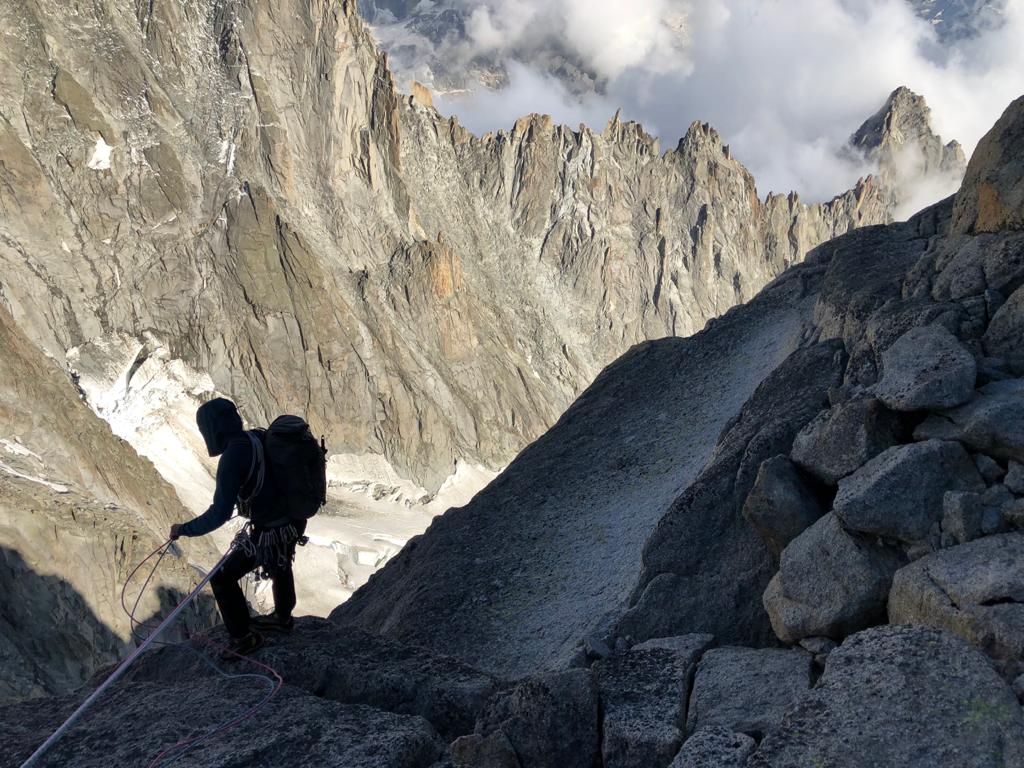
Start of the abseil descent down the South Face
.
We found it and the following abseils confirmed we were in the right place. I was expecting a clean steep granite abseil descent, however it is quite the opposite – long abseils down big mountain terrain with huge gullies with some complex route finding. Having said that the abseils worked and Will did an amazing job of navigating and route finding from one abseil to another. It was also safer and less dangerous than the alternative side of the Petit Dru descent which late in the day has some loose rock potential. I have used the alternative descent off the Petit Dru before with Nick Bullock when we climbed the American Direct which took us 2 days to climb and 3 nights out, including a bivouac on the summit.
Things were going well, and we were making progress abseiling down the South Face, we both agreed this would be difficult in the dark, especially locating the abseil points. So we tried to keep pace and be efficient as it was going to be dark soon. We lost count on how many abseils we had done, maybe 10 or 11, and the glacier was insight.
.
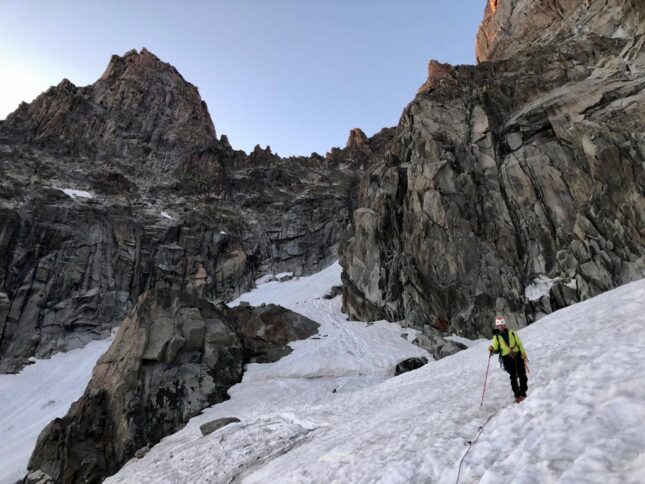
.
High above the glacier we took the opportunity to plan a route through the crevasses. This was a concern and we were both reassured to see a clear passage and a faint track. The very last section of the day was to cross the Charpoua glacier to the hut. We completed the last abseil and continued to tie back on to the rope for glacial travel. It was late in the day and we knew there were many crevasses to negotiate. Pleased to be off the mountain we set off cautiously down the steep Charpoua glacier.
.
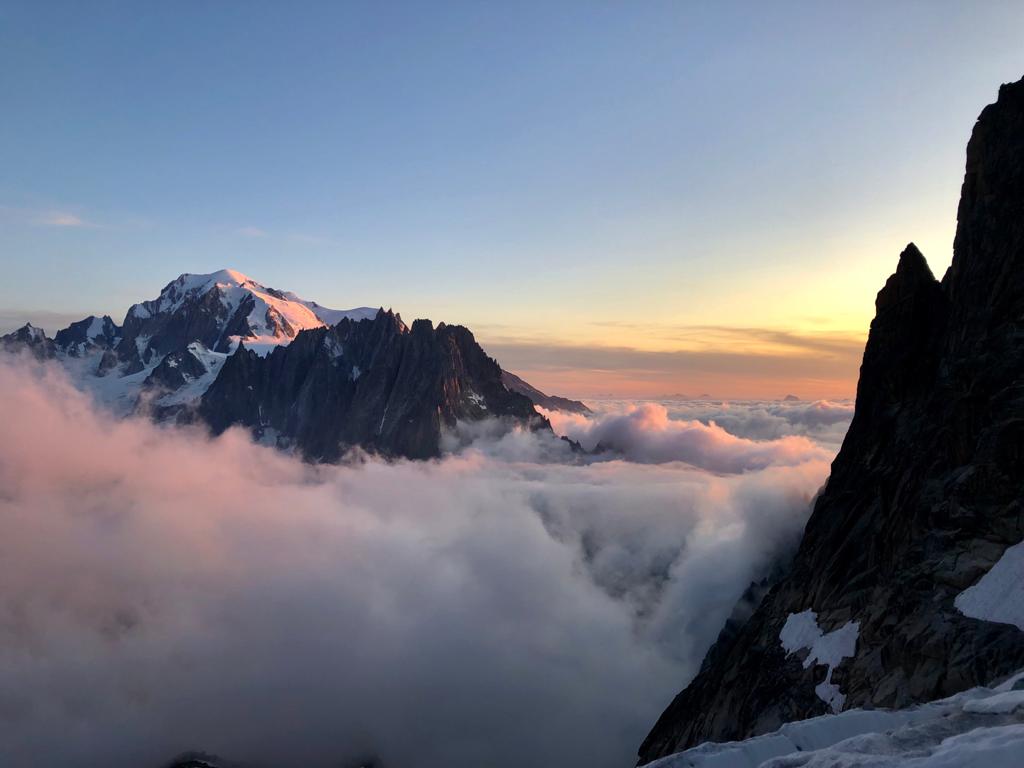
Mont Blanc in the evening light
.
There was a faint track to follow from other climbers traversing the Dru. We were thankful for this as we were tired, and it was getting dark. An hour later we were off the Glacier and approaching the Charpoua Hut with headtorches on and in the dark. The hut was a welcome sight, we knew the hard work was done and could relax.
After a little sleep at the hut, we woke up to a clear, quiet morning. Standing outside the hut we looked back up at the mountain, happy and reflecting on the climb and yesterday’s efforts. The Guardian of the hut kindly made us an amazing late breakfast with the best ever coffee. We wished we could stay longer and relax at the hut, but we had to descend to the valley.
.
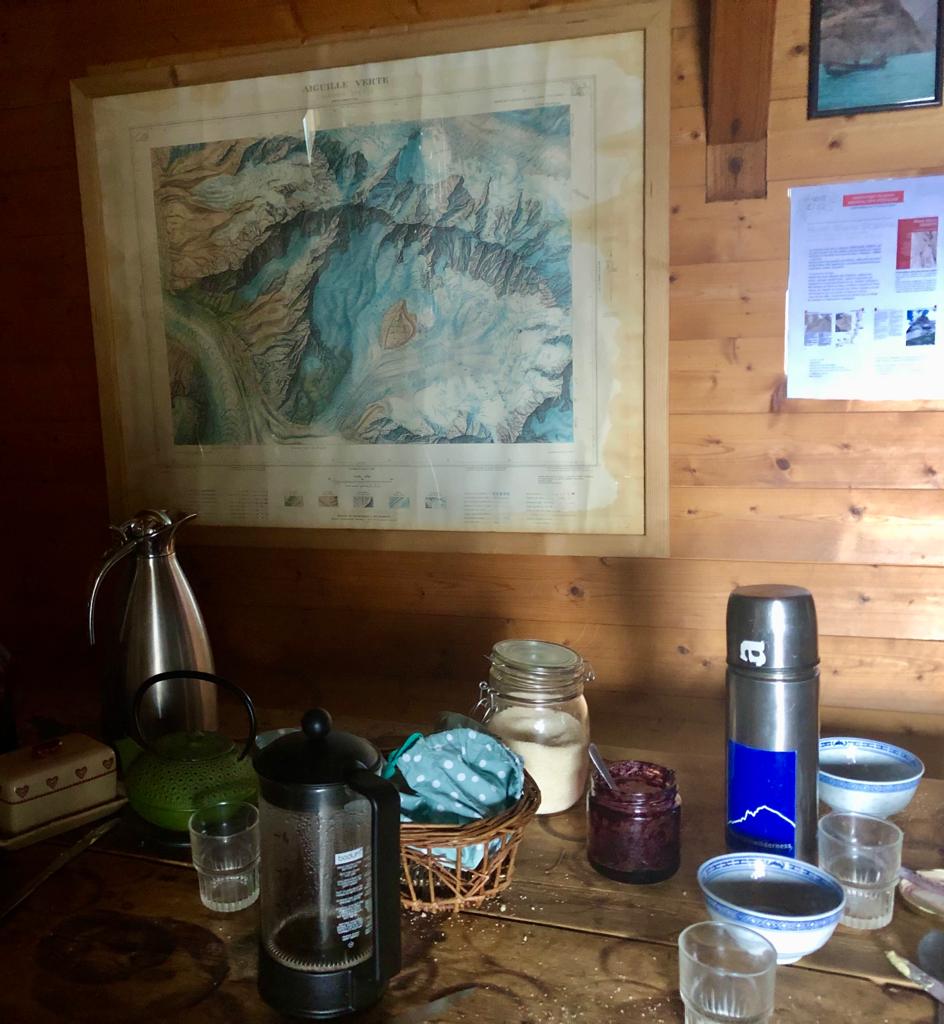
.
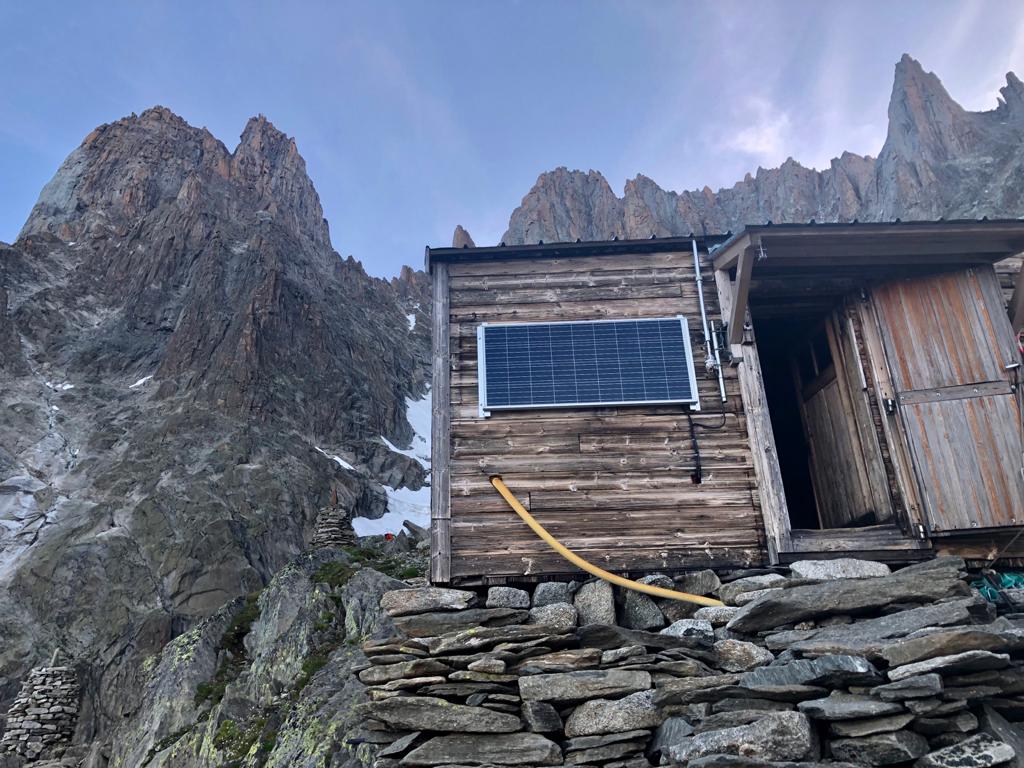
..
The weather was good and a nice temperature for walking, still early in the day with clear views of all the mountains around. Looking forward to some home comforts, we walked slowly down the glacier Mer de Glace, often looking back up at the Dru, happy and proud of efforts on our long day out on the Dru North Face.
.
Don’t miss the first in the series:
.
About Stuart McAleese
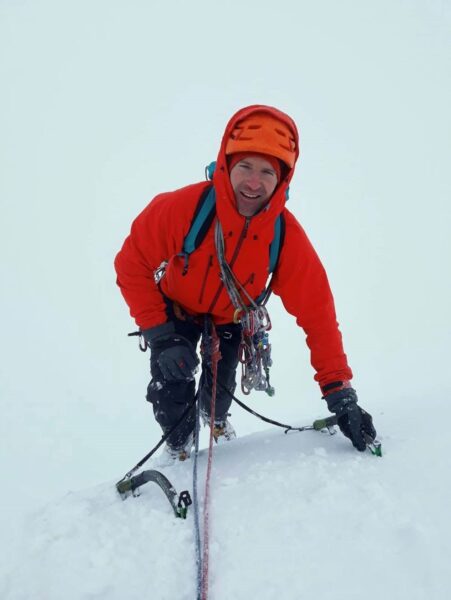
Originally from Northern Cumbria I started out hill walking in the Lake District when I was at school. I soon become interested in rock climbing and mountaineering, and was lucky enough to work and climb with Mountain Guides during my first job leaving school. Since then I’ve been working full time in the mountains for around 20 years.
At the same time as working, I enjoy climbing in my free time and have been lucky enough to go on many expeditions around the world, climbing new mountains, first ascents and tough remote summits. Places such as Patagonia, Alaska, Himalaya, Peru, Baffin Island, Yosemite and China. In 2004 I was nominated for the prestigious Piolet d’Or in Grenoble, France, for a 1st ascent of the ‘Supa Dupa Couloir’ in Alaska.
I love my job as a Mountain Guide, teaching and exploring big mountains in all weather all year round. I joined the Glenmore Lodge team in 2019.
.